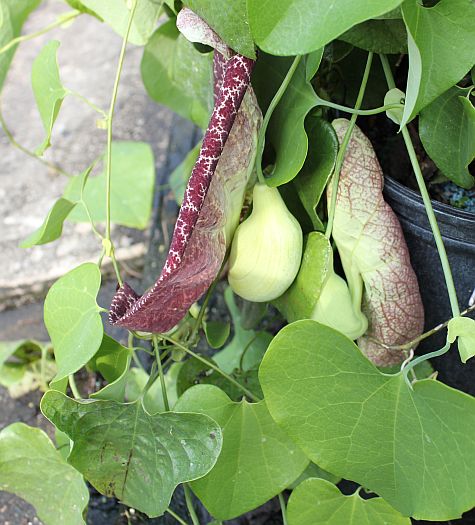This is a tale of three plants in my garden that would make the cruelest of multiple choice answers. Heh. Hence the inclusion of all three in this post:
a. Manihot esculenta
b. Abelmoschus manihot
c. Abelmoschus esculentus
d. All of the above
e. Aaaargh.
Manihot esculenta is Cassava or Tapioca; worthy of an entire post on its own. But the choice ornamental version is M. esculenta ‘Variegata’ or variegated tapioca. I first saw it (gawked and squealed, actually) at Allan Armitage’s fab trial garden at the University of Georgia. Full sun, hot as blue blazes – not the usual environment variegated plants thrive in. But this South American native loves it. It’s worked its way north in the trade; now nearly every plant nerd garden has it. Perfect in beds or containers, it makes a lovely, well-behaved clump in temperate zones – a big shrub in warmer areas. Interestingly, Manihot is in the Euphorbiaceae family; the other two are Malvaceae (hibiscus family). Hardy only to Zone 9, unfortunately.
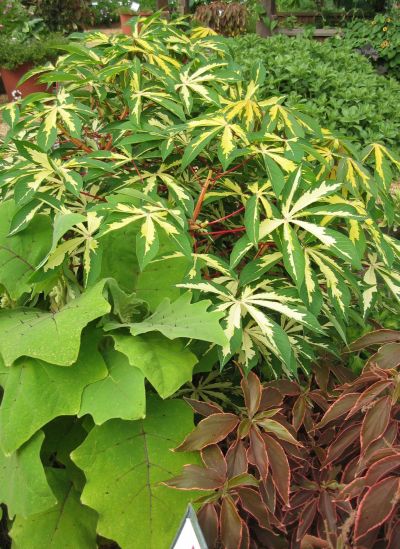
Manihot at the UGA garden in 2004. Love those red stems!

In our home garden. A bit of a shady spot, hence the less-vivid coloration.
Abelmoschus manihot is variously known as sweet hibiscus, sunset hibiscus, etc. and remains rather obscure. It’s easy to grow from seed, plus reseeds gently where happy (like the gravel paths in our kitchen garden). Not much to look at until late summer, then the big lemon-yellow flowers unfurl – usually one or two at a time on each plant. The seed pods march up the stem, resembling a smaller version of okra. Gets tall – up to 6’ or so – but the sturdy stems don’t need staking. Collect seeds from the dried pods to start next year.
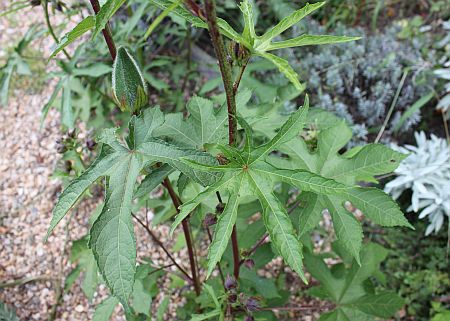
The foliage is edible – I’ve gnawed a leaf or two but was underwhelmed. Maybe in soup.
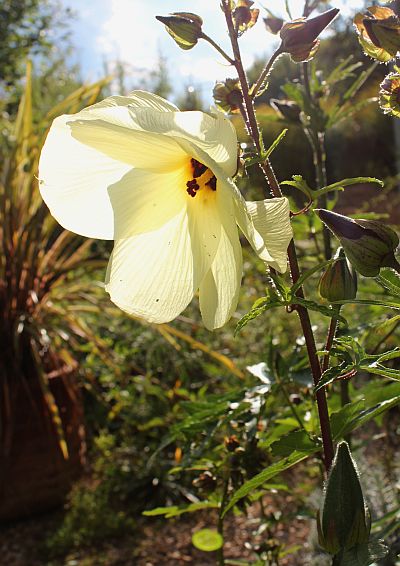
The flower of Abelmoschus manihot is very similar to but a bit larger than those of okra…
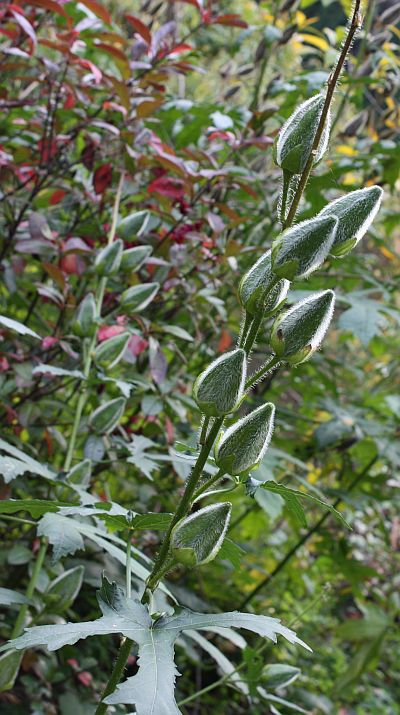
Marvelous pods in the fall at Chanticleer.
Finally, the most common – Abelmoschus esculentus – Okra. Hitting its stride right now in the home garden. Extremely ornamental, especially the red-stemmed varieties.

Okra ‘Hill Country Red’ at the Atlanta Botanical Garden this summer. Gorgeous!

The important bits.
Okra is a very unique veg. You may be cringing from some past okra mishap, but I urge you to try it 1) fresh and 2) prepared correctly. Yes, it’s a bit mucilaginous, but what makes it gooey also serves a wonderful thickener for gumbo, stews, and the like. Pickled okra makes an exceptional cocktail garnish for vodka martinis (add a splash of hot sauce for a Cajuntini). I love okra dearly but never buy it in the store – as it sits around, the pods become woody and tough. Try it fresh from the farmer’s market or even better, the back yard. Not trying add to the food-blog-saturation point, but please allow me to wander off-topic and share my favorite fried okra recipe. The deep-fried, breading-buried stuff normally sold as
fried okra is far, far inferior.
Holly’s Fried Okra
(Materials and Methods)
Pick a mess* of okra. Slice up your pods (no more than ¼” to 1/3″ sections. If it’s difficult to slice, discard that pod – too old/tough) and toss into a bowl with a sploosh of buttermilk, just enough to moisten it. Add salt, pepper, and a dash of cayenne. Stir gently. Get a big fry pan or wok (okra needs its space) and heat some veg or olive oil. Not a lot, just a few tablespoons. Don’t let oil get smokin’ hot, don’t want to burn it. Now throw a big handful of cornmeal into the bowl with the okra and stir gently again. Some will stick, some won’t. You should be able to see the okra, not just blobs of coating. Move okra to hot pan with a slotted spoon, giving it a shake over the bowl so you don’t get a lot of extra cornmeal in the pan. Just enough for one layer – don’t crowd the pan or it will be soggy. Toss gently over medium heat for about 5 to 8 minutes until some corners are very dark brown and crispy and everything else is either green or golden. Remove to paper towel-covered plate; add a dusting of kosher salt, then start the next batch (replication). Eat the first batch while standing there making the second batch. Helpers will magically appear. The first batch NEVER makes it to the table in our house.
Crispy, non-greasy, okra goodness!
*mess = “as much as you need for your meal”, be it for two or ten. This recipe uses about three cups of slices – though can’t say I’ve ever measured. Enough to feed two or three (two if they really like it). Adjust other ingredients accordingly.

